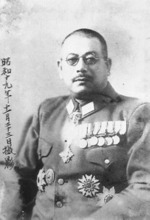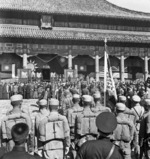Hiroshi Nemoto
| Surname | Nemoto |
| Given Name | Hiroshi |
| Born | 6 Jun 1891 |
| Died | 24 May 1966 |
| Country | Japan, China |
| Category | Military-Ground |
| Gender | Male |
Contributor: C. Peter Chen
ww2dbaseHiroshi Nemoto was born in Fukushima Prefecture, Japan into a farming family. His father was active in the village government. In 1904, he enrolled in a military school in Sendai, Japan. In May 1911, he graduated from Japanese Army Academy as a junior officer in the infantry. In Dec 1911, he was promoted to the rank of sub-lieutenant. In Dec 1914, he was promoted to the rank of lieutenant. In Apr 1921, he was promoted to the rank of captain. In Nov 1922, he graduated from the Army War College. In May 1923, he was given command of a company with the 27th Infantry Regiment. In Dec 1923, he was attached to the China Bureau of the Army Chief of Staff. He was married to the daughter of a high level postal official in 1924; they would have four sons and two daughters together. In 1926, he was dispatched to Nanjing, China as a military attaché, where he would make the acquaintance of Chinese President Chiang Kaishek. While in China, he was promoted to the rank of major in Aug 1926. In Mar 1927, he was seriously wounded by the combination of the bayonet of a Chinese Army nationalist and by the fall he made out of a second story window while escaping his attacker; he was sent back to Japan to recuperate from his wounds. In Sep 1927, he was attached to the Army Ministry in charge of China affairs; around this time, he became active among the group of aggressive officers who believed Japan should expand its influence into the Manchurian and Mongolian regions of China. In Mar 1929, he was dispatched to Germany as a representative of the Japanese Army Chief of Staff, returning in Dec 1929. In Aug 1930, he was promoted to the rank of lieutenant colonel. In Oct 1930, he was implicated in a failed coup d'état attempt, forcing him to become conservative in his actions in order to maintain his career. In Aug 1932, he was dispatched to Shanghai, China for the Army Chief of Staff. In Jul 1933, he was assigned to the headquarters of the Japanese Army in China. In Mar 1934, he returned to Japan to oversee munitions production. In Aug 1934, he was promoted to the rank of colonel. On 26 Feb 1936, a group of Army officers staged a coup d'état that was brutally suppressed by the government; it was said that Nemoto was involved this coup, but he was saved from certain arrest and possible execution because he had overslept and missed the early morning actions. In Mar 1936, was named the commanding officer of 27th Infantry Regiment.
ww2dbaseIn Sep 1937, after the outbreak of WW2 in Asia, Nemoto was transferred to the headquarters of the Japanese North China Area Army. In Jul 1938, he was promoted to the rank of Brigadier General. In Aug 1939, he was briefly recalled to Japan to serve with the Army Chief of Staff before returning to China as the Chief of Staff of the 21st Army based in Guangzhou, Guangdong Province, China in Dec 1939. In Feb 1940, he was named the chief of staff of the Japanese South China Area Army. In Mar 1941, he was named the commanding officer of the 24th Division. In Feb 1944, he was named the commanding officer of the Third Army of the Japanese Kwangtung Army based in northeastern China. In Nov 1944, he was named the commanding officer of the Japanese Mongolian Garrison Army. While retaining his command over the Mongolian Garrison Army, he was concurrently made the commanding officer of the Japanese North China Area Army in Aug 1945 to deal with the surprise attack by Soviet forces, which had unexpectedly tore up the Russo-Japanese non-aggression pact. Nemoto ordered his inadequately-prepared troops to do their utmost against the attackers, while covering the southward evacuation of about 40,000 Japanese civilians. Meanwhile, he attempted to negotiate a ceasefire with the Soviets, citing the Japanese surrender announcement of 15 Aug 1945, although to no avail. In the face of a continued Soviet offensive, he ordered his men to continued the fighting in self defense; conflicting with Emperor Showa's wishes, he told his subordinates that he would alone face any responsibility for such an order, and the men on the front line should continue to fire on any Soviet soldiers who crossed into Japanese lines. He directed a series of successful actions against Soviet regulars and Chinese Communist guerrilla fighters, falling back from the Russo-Chinese border region toward the Great Wall, with 40,000 Japanese civilians in his midst, reaching China Proper on 22 Aug 1945.
ww2dbaseAfter the war, Nemoto remained in China as the highest ranking Japanese general placed in charge of disarming and repatriating remaining Japanese troops in China. He returned to Japan in Aug 1946, where he and his family would live in the Tsurukawa district of Tokyo. In 1949, as the situation became dire for the Chinese Nationalists, he decided to offer his assistance. Stories differed on how he was inspired to join the Chinese Nationalists, whether he volunteered his services on his own or if Chaing Kaishek secretly dispatched a representative to seek him out, but regardless he made the journey, with six other Japanese veterans with similar anti-Communist intentions, from southern Japan to Taiwan in Jun-Jul 1949. He was briefly interned by Chinese coast guards at Keelung who knew nothing about them, but was freed as soon as Lieutenant Generals Peng Mengji and Niu Xianming caught the word of his arrival. He met with Chiang personally in mid-Aug, who dispatched him to Xiamen in mainland China three days later. Under the pseudonym "Lin Baoyuan" with a rank of Lieutenant General in the Chinese Army, Nemoto served as a senior adviser to General Tang Enbo of the 5th Military Area. Tang entrusted Nemoto to plan the evacuation of Xiamen to the nearby island of Kinmen (Postal Map: Quemoy), and he was heralded as a key figure in the successful defensive Battle of Kuningtou that stopped the Chinese Communist forces from taking Kinmen between 25 and 27 Oct 1949. Even though his officially responsibility was that of an adviser, he personally saw combat on the front lines, directing armored units assaulting the Communist beachhead on the northern coast of Kinmen. He returned to Taiwan in late 1949 and was awarded a rare Jingde County porcelain vase (only three pairs were hand-made for the occasion of British Princess (later Queen) Elizabeth's 1947 wedding, the best pair of which was given to the princess, and Chiang broke up the pair in his personal collection for Nemoto). He returned to Japan in Jun 1952; the Chinese and Japanese governments reached an agreement so that his illegal travel from Japan to Taiwan back in 1949 would be overlooked by Japanese law enforcement agencies.
ww2dbaseDue to anti-Japanese sentiments in the few years after WW2, Nemoto's participation in the defense of Nationalist territory against Communist offensives was kept a secret for many years. The government of the Republic of China did not mention Nemoto's name in any official documents nor in any announcements until 2009.
ww2dbaseSource: Wikipedia
Last Major Revision: Jul 2015
Hiroshi Nemoto Interactive Map
Photographs
 |  |  |  |
Hiroshi Nemoto Timeline
| 6 Jun 1891 | Hiroshi Nemoto was born in the village of Niida, Iwase County (now part of the city of Sukagawa), Fukushima Prefecture, Japan. |
| 1 Dec 1909 | Hiroshi Nemoto was enrolled in the Japanese Army Academy. |
| 27 May 1911 | Hiroshi Nemoto graduated from the Japanese Army Academy. |
| 26 Dec 1911 | Hiroshi Nemoto was promoted to the rank of sub-lieutenant. |
| 1 Dec 1919 | Hiroshi Nemoto was enrolled in the Japanese Army War College. |
| 29 Nov 1922 | Hiroshi Nemoto graduated from the Japanese Army War College. |
| 1 May 1926 | Hiroshi Nemoto arrived in Nanjing, China as a military attaché. |
| 9 Sep 1927 | Hiroshi Nemoto was attached to the Army Ministry in Tokyo, Japan and was placed in charge with China affairs. |
| 8 Aug 1932 | Hiroshi Nemoto arrived in Shanghai, China. |
| 4 Jul 1933 | Hiroshi Nemoto was attached to the headquarters of the Japanese Army in China. |
| 5 Mar 1934 | Hiroshi Nemoto was givern responsibility of the production of munitions in Japan. |
| 1 Aug 1934 | Hiroshi Nemoto was promoted to the rank of colonel. |
| 7 Mar 1936 | Hiroshi Nemoto was named the commanding officer of 27th Infantry Regiment. |
| 4 Sep 1937 | Hiroshi Nemoto was attached to the headquarters of the Japanese North China Area Army. |
| 14 May 1938 | Hiroshi Nemoto was placed in charge of the Special Operations Department of the Japanese North China Area Army. |
| 15 Jul 1938 | Hiroshi Nemoto was promoted to the rank of Brigadier General while in China. |
| 1 Aug 1939 | Hiroshi Nemoto was attached to the Army Chief of Staff in Tokyo, Japan. |
| 1 Dec 1939 | Hiroshi Nemoto was named the chief of staff of the 21st Army based in Guangzhou, Guangdong Province, China. |
| 10 Feb 1940 | Hiroshi Nemoto was named the chief of staff of the Japanese South China Area Army. |
| 1 Mar 1941 | Hiroshi Nemoto was named the commanding officer of the 24th Division in China. |
| 7 Feb 1944 | Hiroshi Nemoto was named the commanding officer of the Third Army of the Japanese Kwangtung Army based in northeastern China. |
| 22 Nov 1944 | Hiroshi Nemoto stepped down as the commanding officer of the Third Army of the Japanese Kwangtung Army and was transferred to command the Japanese Mongolian Garrison Army. |
| 19 Aug 1945 | Hiroshi Nemoto was named the commanding officer of the Japanese North China Area Army while still retaining his command over the Japanese Mongolian Garrison Army. |
| 10 Oct 1945 | Hiroshi Nemoto surrendered the Japanese North China Area Army at a ceremony at the Taihe Hall of the Forbidden City in Beiping, China. |
| 26 Jun 1949 | Hiroshi Nemoto departed Miyazaki Prefecture, Japan. |
| 10 Jul 1949 | Hiroshi Nemoto arrived at Keelung, Taiwan, Republic of China. |
| 1 Aug 1949 | Hiroshi Nemoto arrived at a hot springs resort at Beitou, Taiwan, Republic of China. |
| 18 Aug 1949 | Hiroshi Nemoto arrived at Xiamen (Postal Map: Amoy), Fujian Province, China. |
| 25 Jun 1952 | Hiroshi Nemoto departed Taiwan for Japan. |
| 5 May 1966 | Hiroshi Nemoto was admitted into a hospital in Tokyo, Japan. |
| 21 May 1966 | Hiroshi Nemoto was discharged from a hospital in Tokyo, Japan. |
| 24 May 1966 | Hiroshi Nemoto passed away in Tokyo, Japan. |
Please consider supporting us on Patreon. Even $1 per month will go a long way! Thank you. Please help us spread the word: Stay updated with WW2DB: |

» Manchurian Strategic Offensive
» Japan's Surrender
- » 1,171 biographies
- » 337 events
- » 44,911 timeline entries
- » 1,245 ships
- » 350 aircraft models
- » 207 vehicle models
- » 376 weapon models
- » 123 historical documents
- » 261 facilities
- » 470 book reviews
- » 28,521 photos
- » 365 maps
James Forrestal, Secretary of the Navy, 23 Feb 1945
Please consider supporting us on Patreon. Even $1 a month will go a long way. Thank you!
Or, please support us by purchasing some WW2DB merchandise at TeeSpring, Thank you!